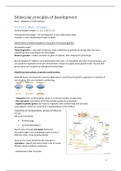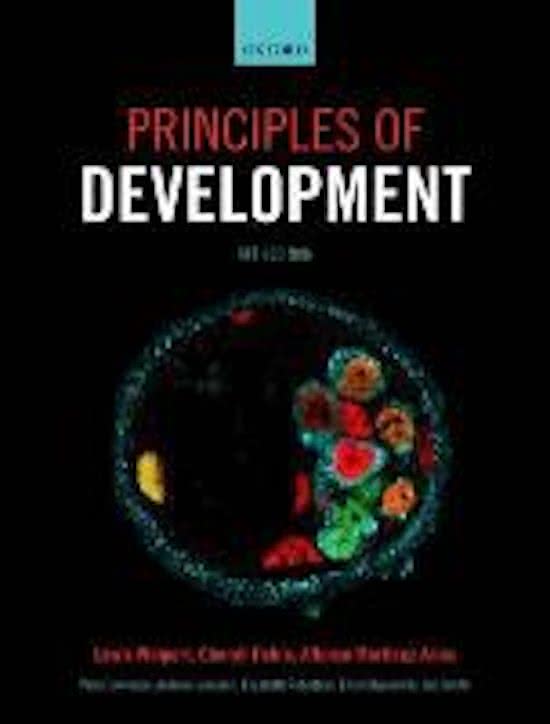Molecular principles of development
Book = Wolpert et al (5th edition)
Lecture 1: Basic concepts
Outline Wolpert chapter: 1, 2.1, 2.10, 3.1-3.2
Developmental biology = the development of the multicellular body
mistakes in early development leads to death
Identification of patterning genes: the power of forwards genetics
Drosophila model:
Forward genetics = start with mutations, look at what the mutations do and go after the most
interesting ones according to the phenotype.
Reverse genetics = make a mutation in gene of interest, then analyze the phenotype
Box 2A Wolpert 5th edition: more detail about this topic > in drosophila you have 4 chromosomes, you
can perform a separate screen per chromosome. People can apply some genetic tricks. You can find
genes which are mutated by looking at the phenotype.
Identifying major players in genetic model system:
Edwards Lewis, Christiane N-V won the Nobel price: used forwards genetics approach, to identify all
sort of genes that are involved in patterning.
- Gap genes (loss of these genes result in a reduced number of segments)
- Pair rule genes (loss allows only odd-number segments to develop)
- segment polarity genes (loss leads to segments with similar head and tail ends)
3 key players: which are involved in in segmentation of the embryo.
OVERVIEW OF DEVELOPMENT, MODEL SYSTEM LIFE
CYCLES
Life cycle drosophila:
fertilized egg
syncytial blastoderm
Sperm entry through micropyle (anterioir)
drosophila egg Is not completely round and has 2
different sides. It has already polarity.
Early on the nuclei divide but the cells don’t =
syncytium = bag of cells that contain a lot of nuclei.
Nuclear division without cytokinesis.
-cellularization after 14 cycles.
1
,So first you get the syncytium bag of cytoplasm > nuclei migrate to the periphery of cytoplasm >
syncytial blastoderm > cellular bastoderm.
Molecule can freely diffuse; syncytium allows for diffusion of proteins.
gastrulation
Major morphogenic process of development: ball of cells becomes an
organism.
If there is one process that you could call the major morphogenetic process
of development it is gastrulation.
Obvious morphological segmentation = differentiation phase.
Figure 2.3 Wolpert 5th edition =Gastrulation and segmentation
But how do these segments arise during this process will be discussed later
Larval stages
hatch indo an adult fly
* whole cycle of life takes 9 days = very fast
Model system life cycles: zebra fish, frog and mouse
- it is easier to start with the frog and fish and then look at the mouse because easier to harvest and
understand.
Drosophila vs. vertebrate development
Maternal axes and symmetry
Drosophila: Anterior-posterior (A-P), Dorsal-ventral (D-V)
Zebra fish , Xenopus = Animal-vegetal (radial symmetry)
mammals = no polarity (point-symmetry)
Syncytium and cleavages
Drosophila: nuclear division, syncytium
Zebra fish: meroblastic divisions (division on top of the egg), yolk syncytial layer
frog xenopus, mouse: holoblastic divison (division in the egg)
Early embryonic cells division time
Drosophila: 9 minutes (genome 140MBp) = very fast
Zebrafish: 15 min (genome 1,700MBp) = very fast
Xenopus: 25min (genome 1,560 MBp)
Mouse: 15-20hours (genome 2,720MBp)
2
,BODY AXES, PATTERNING
Embryonic patterning = process of establishing positional information at the molecular level among
similar cells: if cells arise from a single cell, how do they become different? How do they know what to
do?
Forming body axes: if a cell will just randomly divide we will end up as a ball of cells. Something
dramatic needs to happen to turn that ball of cells into body axes.
- Dorsal-ventral (D-V) = top //bottom
- anterior –posterior (A-P) = nose//tail
- medial-lateral = left //right (L-R)
All that starts with polarity/symmetry-breaking: this can be done in 2
ways:
- asymmetric cell division
- molecular gradients
This all has to do with gene regulation: Patterning is not the same as differential gene
expression. Gene expression is involved but is not the same thing as patterning.
Patterning= process (of symmetry breaking) which establishes differential gene expression
(amount otherwise similar cells) that is directly related to position within the embryo.
Examples: A-P, D-V, L-R. +/- 50 maternal-effect genes in drosophila set up A-P and D-V axes
Maternal factors set up the body axes
Maternal genes:
Bicoid (anterioir) = protein that inhibits translation of mRNA that
encodes the caudal protein.
Caudal protein = only in the posterior part of the embryo.
These are maternal genes: genes expressed in the oocyte, the
genes are already there before fertilization. Maternal products,
when the genes are expressed they are called maternal genes. A lot of them are expressed in
gradients.
So bicoid and caud al (from the mother) > the ratio of these two proteins already informs you where
you are in the cells, posterior or anterior axes.
Zygotic genes: As soon as the oocyte start to transcript/express their own genes after fertilization it
starts to respond to the activities of the maternal protein. > increased specificity and position.
These proteins will induce increased diversity, You have GAP
genes in drosophila that have multiple domains of expression
(because there is a gap in the expression level across the embryo)
GAP + pair-rule genes make a striped pattern.
fushi tarazu (transcription after fertilization) = transcription
factor, snail = transcription regulator, DNA = DAPI-stain.
The cells know where the segments are going to be formed. >
3
, Striped pattern.
GERM LAYERS, INDUCTION, FATE, DETERMINATION
Germ line = type of cell that processes cells from your production.
Not to confuse with Germ layers!
3 major germ layers in humans: 3 basic cell types that form an early embryonic development.
Box 1C, wolpart, 5th edition.
Endoderm: stomach, colon, liver, pancreas, lungs
intestines = the gut
Mesoderm: muscle, heart, blood
Ectoderm: surface epidermis, neural crest,
neural tube (brain, spinal cord)
Understanding what they are, and should
be able to know examples: skin is ectoderm,
muscle is mesoderm, and endoderm is organs
for example.
*Insect have their nerve system on their belly not on the back like as with vertebrates.
Fate maps tell what the progeny of cells will be
experiment: lineage tracing with fluorescent dye
inject a dye in a single cell of a blastomere and sit back and
watch. You can trace what this cell will give rise to > the
progeny of the cell.
The place of the cell in which you inject the dye will end up in
a certain position that is described by the fate map. The
signals which make the cell get to that certain position will be
later in life. This means that at the beginning the cell doesn’t know where it should go.
The cell hasn’t received any information.
There is a stage where the cell has received information to go to a certain position, but the position
of the cell can still change = specification. (Example: if you put a piece of your skin in muscle, it won’t
change. But if you do this in embryo’s, the cells can still change their fate if their exposed to different
environmental signals).
Fate: “we know what the cells (most likely) will give rise to – but the cells do not”
specified: “cells know what they will be, but can change their mind”
Determined: “cells know what they will be and will proceed no matter what”
Fate vs determination
Transplantation experiments:
a piece of the embryo is becoming most likely an eye. > That’s what the fate map would tell you.
If you put that piece of embryo somewhere else in the embryo, it would form a different piece in the
4





